Studebaker and Packard combined resources in 1954 and their separate 1955 models would be the first full year of cars under the new banner. As Packard still tried to maintain its identity, the 400 (or Four Hundred) was offered in 1955 as the top-of-the-line car, but only as a 2-door hardtop. The 400 could be distinguished from the lower series cars by the use of a full color band along the lower portion of the automobile topped by a partial color band that truncated along the rear edge of the front doors. Production numbers were relatively small, so it’s surprising to find three of the cars together in one place. The seller mentions two Packard’s, but a third parts car is shown, so we’ll assume it’s a take all proposition for $15,000, OBO. These cars are available in Spokane, Washington and here on Facebook Marketplace.
The Packard 400 was built by the combined Studebaker-Packard Corp. for 1955 and 1956. They were built in Packard’s Detroit facilities which would close after the 1956 model year. In the early 1950s, Packard used numerical references as nameplates for their cars. The 200 and 250 Series were the junior cars and the 400 would be the senior (again, just for hardtops; the Patrician was the sedan version). The name “The Four Hundred” in gold anodized script was applied on the band between the front wheel well and door edge.
The 1955 400 would use a 352 cubic inch V8 that produced 260 horsepower with a 4-barrel carburetor. An automatic transmission was the only logical choice to pair up with a car of the 400’s stature. Likely because of the well-publicized struggles of both Studebaker and Packard, buyers didn’t flock to Packard dealerships in droves. They built 7,206 400’s for 1955 and another 3,224 for 1956. For 1957, anything Packard was strictly a rebadged Studebaker and the Packard brand would be gone altogether for 1958. The merged company would manage to hang on another eight years, thanks mostly to the success of the Studebaker Lark in the late 1950s/early 1960s.
In the photos, you’ll see two cars huddled together under an open shed. These are the two cars the seller is focused on, saying they’re complete cars that have been in Washington State for a long, long time. There is no reference as to their individual condition (i.e., rust or body damage) or if either of them is anywhere close to running again. The third vehicle, pictured outdoors, is described as a parts car, so its condition is likely far worse. They need to find a new home, so the two complete cars and possibly the parts car are offered as a package deal. Hagerty pegs the 1955 400 to be worth $6,300 in Fair condition and $45,000 as show quality. So, what would it take to create $90,000 worth of cars out of an initial $15,000 investment?



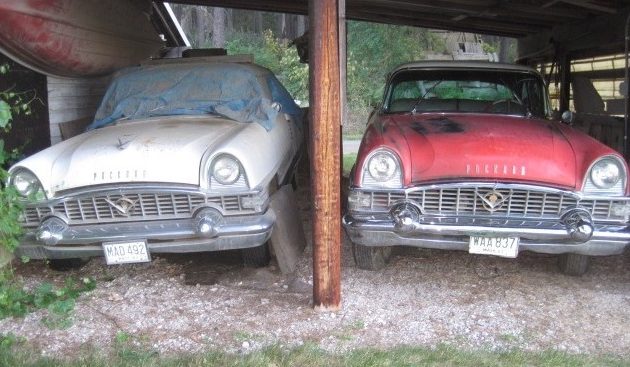
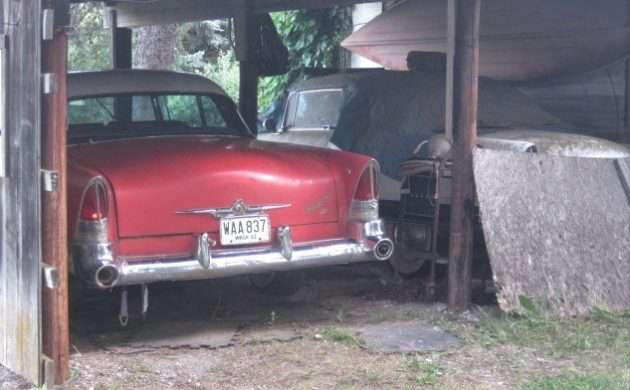
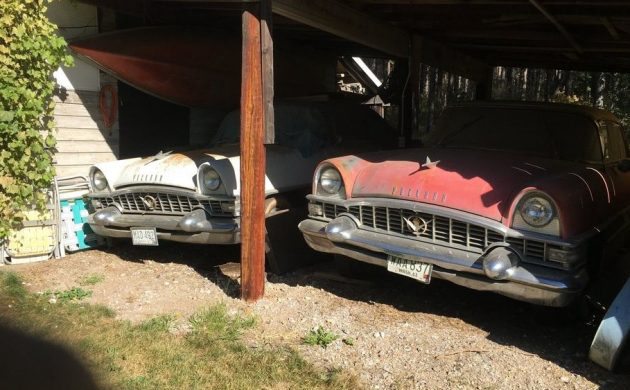

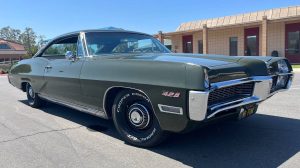
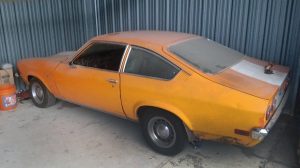
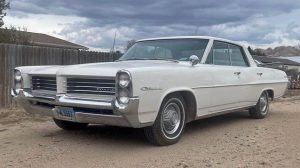
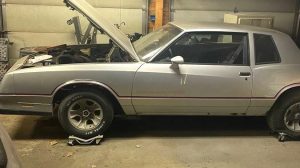


The fact that these cars have been listed for 24 weeks with no takers gives you some idea about the popularity of Packards these days. And ask yourself, when was the last time you were hanging out with somebody, maybe talking about cars or doing some shade-tree wrenching, and they gazed off wistfully into the distance and said, “One of these days, I’m going to get me a Packard!”?
Actually, yes, I’ve heard those words, as well as “Wow, check out this Packard that’s pulling in” as conversation fades and the group edges over to the new arrival, yes, definitely.
“A Pack of Packards”. Rare and beautiful!
Worth more as a parts source for better Packards.
Packard came with color coordinated shift knobs,dash boards and interior fabrics. No wonder the didn’t earn and profits.
Jeff W,
Packards first came out with color matched shift knobs in 1939, even on the cheaper cars. In 1940 they offered plastic dash pieces in several colors. In 1941 they offered color matched interiors of gray, tan, green, and blue upholstery materials, along with the metal wood-grained panels in matching colors. Yes, you could get light green or light blue wood-grained panels with green or blue seats! and these were available in the Packard 110 Deluxe Six and the 120 Deluxe Eight, not just the more expensive senior Packard 160 and 180 cars. A quick look at the Packard 110-120 brochure will show the color interior choices, over 260 combintions were available!
Here is a color link showing the cheaper Packard 110 Deluxe Six with the gray and blue interior with the gray wood panels;
http://www.lov2xlr8.no/brochures/packard/41pack/241pack.html
In 1942 thru 1950 the Custom Eight cars were standard equipped with some of the most beautiful interiors ever made up until that time, they were offered with tan, dark maroon, dark green, and dark blue 100% wool broadcloth. The matching headliners had ribs that stretched, not from side to side, but front to rear, making the interior look about 5 feet longer than it really was. The carpeting was called “Mosstread” and to this day no one has been able to re-create such a comfortable matching carpeting.
All of the above special color interiors were created when Packard was at it’s best, not at the end. But yes, like almost all luxury cars in 1955 & 1956, Things like a shift knob and dash padding were often color coordinated.
As for being profitable, Packard was turning a profit right up until the end. They stopped production because Studebaker was NOT turning a profit, and now that the 2 were part of the same company, the insurance companies, long used by all the car companies to provide up-front money needed for re-tooling, balked and refused to ante-up.
So because the corporation was producing 10 times as many Studebakers as Packards [never mind that they were making a profit on each Packard and losing money on each Studebaker], they chose to continue with the Studebaker line.
Now about the “Mosstread” carpets & wool broadcloth upholstery: If you ever go to a show and see a 1946-47 Packard Custom Super Eight 180, or a 1948-50 Packard Custom Eight automobile, with a beautiful original interior, ask the owner if you can take your shoes off and sit in the back seat, and let your body relax in that luxurious seat, as your feet are cradled in the carpeting!
I’ve owned over 20 vintage Rolls-Royces, Bentleys, Daimlers, Cadillacs, and Lincolns, some created by famous coachbuilders, but not one could match the comfort of the interior of my 1948 Packard Custom Eight limousine.
Bill M. A 1948 Packard 2 door was the first car car I rode in,came from the hospital in one age 2-3 days. my dad bot it new ,,for somebody else cause cars were hard to come by after the war,,,,well the guy didnt take it so dad was stick with it 3 speed straight 8 and 10 miles to the gallon, and I always got car sick in it well quite a bit,,tan bottom and greyish greenish top $3000.00 I have the reciept and the car restored it to drive 20 yrs ago drove it about 10 yrs and gas went bad ,,have not gotten ti it yet maybe this yr
Jeff,
Thanks for the family car story, I love to read where family members DO keep their cars and pass them down to keep it in the family.
I’m interested to find out which version of the 22nd series Packard 2-door cars you have. If you got lucky and the first four digits indicate it’s a Custom Eight version, they are very sought after and bring big money today.
Packards have a drain plug in the fuel tank, it’s brass, so they never freeze or rust & are easy to remove & drain the tank. That said, if there is less than 1/4 tank of fuel, I would just fill it with premium octane fuel, the car should run fine on that blend.
If you have the opportunity, please make a copy of the original sales receipt and let me see it. I can often tell a lot from the info on it, and I’ll gladly share all the info on what your car is. I can also check to see if the dealer is listed in the Packard Info master dealership list, if not listed, I’ll add it.
My email is simple, it’s billmccoskey [at] aol,com.
Did you ever wonder why cars are just parked and forgotten. I understand sometimes maybe a repair or two is more than the car is worth but when people say ram well when parked ????? I’ve never done this to a car. Hey honey I think we are done with the VW. I’m just gonna put it out behind the shed. Lol
I’ve always thought the same thing. When you see like a ’55 Chevy in a barn that’s been there for 40 years and the ad says “ran when parked” it make me wonder why it was left there for 40 years if it runs.
If I live another 85 years I will never understand the fascination with mid 1950’s Chevrolets.There was nothing there for the quality buyer and making a cross country trip in one when the poor seats and noise from the tires and factory installed rattles are in and of themselves a detriment and tiring,Maybe someone can offer a good reason to restore such a car.
Sometimes a car is not really worth any more effort to repair but still too good to consign to death in a junkyard.A fine old mechanic I knew in the past would tell people to “Junk them while they are running and save the tow bill”.Some thought it was amusing and others got mad.I rhought it was good garage humor and still do.
Unless your a Packard guy this would involve hauling 2 or maybe 3 cars. Not many decent pics of under hood or frame or interiors. Dont guess any are running either. Big gamble if you dont have the money and patience. And of course the room!
Actually, yes, I’ve heard those words, as well as “Wow, check out this Packard that’s pulling in” as conversation fades and the group edges over to the new arrival, yes, definitely.
Packard actually was doing rather well before its hurried merger with Studebaker.
It seems whenever a auto manufacturer is bought out by another company it dies on the vine. (Hear that, Chrysler?)
Maybe 1949 – 50 -51 but not really. Studebakers money kept them alive for a few years more. The 1954 – 55 – 56 were already designed by the Packard team – their sales is what sunk them and they took Studebaker down too !
The 1954 model did not sell well at all and the problems with their automatic transmissions helped not at all.I remember seeing 1955 Packards up on jackstands at Campbell Packard here in Huntington WV and the same in Charleston.
Nobody at that time knew much about the Ultramatics and guessing as to what was wrong didn’t work either.These elegant cars were a laughing stock.The people that bought the rare standard shift 55 and 56 Packards got a great car that worked for years.A local funeral director and a book keeper at a local saw mill each bought a new standard shift
Packard after getting past the lies told by the local Packard dealer that there was no such car available.Nobody wants to admit they were selling fancy junkers as a luxury car.
I am 85 years old and have no good memories of the 55 and 56 Packards that lost value at a startling rate.
Stillrunners,
It was Packard that bought Studebaker, and only after the deal was done, did Packard discover the other company had been keeping 2 sets of books. In reality Studebaker was hemorrhaging money on every car sold. It was Curtiss-Wright that stepped in and bought control, only to steal Packard’s defense contracts, and then ignore the company’s need for re-tooling capital.
I am an enthusiast of these cars, and if I had the room and not involved with several other projects I would jump on them.
A gentleman in my neighborhood bought a new two-tone blue one. It didn’t take long for the kids in the neighborhood to discover its self-leveling suspension. Three or four of us would hop on the rear bumper, causing the suspension to rise to compensate for the extra weight. Then we’d jump off the bumper and watch the suspension lower the car to its normal height. (Hey, we were bored and this bit of technology brightened our day). The car itself was a beautiful example of a dying brand of cars. Of course, we didn’t realize it at the time. As I recall, I think he kept the car for a couple years and sold it, purchasing a Jaguar sedan, whose hood seemed to stay open much more frequently than lowered. He paid us a considerable amount of money because it had to push-started so often.
Torsion level suspension,another idea that fell flat.The two men that insisted on manual transmissions also rejected it in favor
of coil and leaf springs.What you did as a kid could have been stopped by turning the power off to the load leveler like I did on the 55 Patrician I had.As far as I know,there were no other similar systems offered by Ford,GM,Chrysler or any other American makers.
Your comment about the former Packard owner getting a new Jaguar was par for the course.One Jag owner said his only ran on Thursday and rusted into the ground the rest of the time,
We have been married for 52 years and have had 6 Lincolns,2 Buick Electra 225’s,2 F150 Ford trucks and a 1951 Packard 200 I bought as a hobby car from the original owner that wanted the garage space.All 16 valves were replaced and after a year I rebuilt the Ultramatic with new clutch pack,oil seals,cleaned valve body and bronze bushings.It worked fine and was still working when I sold it 2 years later.
Bernie,
When my best friend bought his first Packard, it was a 1955 Patrician, and because we were both not of driving age when it first sat in the driveway [I was 15, he was 14], We also gave “demonstrations” to friends, on how well the Torsion Level suspension worked.
I have had the opportunity to discuss the Torsion Level ride in detail, with several of the engineers responsible for it’s design, construction, and layout.
The initial electrical power design called for the suspension to be activated when the ignition switch was turned on, and to stop working when the switch was turned off. Problem was, most drivers turned the ignition off before people exited the car, often resulting in the back of the car raised too high. So they changed it so the power was always to the system, however they did install a cut-off switch under the dash, to the left of the emergency brake.
The company did begin receiving complaints about kids running the battery down by “riding the back bumper”, so they began a run-around for later production, slated for the 1957 models.
What they had planned was simple:
When the ignition switch was turned off, the leveling system would still receive power, provided the suspension was not at the “neutral” point [either too high or too low]. Once the normal 7-second delay kicked in, the suspension would level itself, then once the “neutral” section of the switch was reached, the suspension would be inactivated until the ignition switch was again turned on.
The change was simple, with the addition of one switch and a couple of relays. It’s likely this could have been retrofitted into existing cars as well.
Many owners, including myself, installed another power antenna switch in place of the on/off switch, and ran 2 wires down to the suspension relays, so we could manually change the ride height. Push up on the switch to raise the back end, and pull down to lower it.
In my late 20s I had a hi-performance 1955 Packard 400 hardtop with a 1956 Packard 374 engine, Caribbean dual quad carbs, stick shift & overdrive, and headers to the dual exhausts. In 1968 Maryland made it illegal to “jack-up” the rear suspension, because that indicated the car was made for racing. If the rear bumper was 4 inches or more higher from the factory setting, it was considered illegal.
One time I was “aggressively” driving the Packard, and another car was doing the same, but in a different lane not far from me, so a local county policeman pulled us both over. The young officer first went to the other driver, gathered his info, then he headed over to me.
By the time he got to my car, it was completely level. He asked me if I was in a speed contest, and feigning a look of surprise, I pointed to the car [in need of rust repair & paint], and said “Does this look like a race car?” He asked me what the car was, and I said it’s an old Packard. He had never heard of a Packard. I explained they made luxury cars, not sport cars.
Neither one of us got a “speed contest” ticket that night, but the other driver did get a ticket for his car’s bumper height.
Take a drive through Missouri, and there is 3+ vehicles behind every house or barn. Same thing occurs on Indian Reservations, they drive them until they stop running, and to the back it goes. I used to work at an auto service center, the car would come in for an LOF. It would have 50k on it with the factory filter never being changed. Now why they hang on to them is another animal, ” I am going to get to it someday ” is the worst. We have all seen derelict, once proud vehicles, slowly deteriorate into rust piles, never to feel pavement again. That is the end result the hurts everyone.
I’ve always liked these cars but never
could afford one. When I say “these cars,” I’m talking about the ’55-’56 models as I’d already owned a ’50 8
passenger limo in the early ’70s and had
a whole lot of fun hauling my band and
our instruments around with it. But the
’55-’56 models, I’ve always wanted one.
They were sharp cars then and they are
even better looking cars today. If you’re
able to do it right, you could save all
three of them and put ’em back on the road where they belong. Do the better
one’s first, and then drop a 400 GM big
block with a T-400 tranny into the parts
car. Saw a ’56 model in Tampa a few
years back that had this combo in it
and it was very nicely done for what it
was. But who am I kidding. Don’t have
the cash or space to pull it off so I’ll just
wipe the drool off my keyboard and just
use ’em for portrait practice.
Kenneth,
The Packard V8 engine was a very well designed piece of work. Other than the early cars having a problem with a shaft seal between the oil pump and the vacuum pump that would result in the lifters being starved with oil [this was fixed within a couple of months of production] they are almost bullet-proof.
The designers also anticipated the continued horse power and cubic inch race, so the ’55-’56 Packard V8 was designed so it could be bored & stroked to have a displacement of around 500 cubic inches!
The Twin Ultramatic transmission was indeed rushed into production by James Nance, and it had teething problems. But by the end of the 1956 production, improvements to the transmission had made it quite reliable.
However in 1956 they brought out the electronic shifting “piano”, and it took a little longer to solve the problem of the electrical contacts overheating. but once that has been done to existing cars, it too, is quite reliable.
One solution to the Twin Ultramatic problem is to replace it with a Chrysler 727 Torqueflite transmission, and there is a company that has a kit to accomplish this swap.
The V8 Packard was possibly the finest ever made and it was so simple;I call is a K.I.S.S.engine (KeepItSimpleStupid) and as I recall,both heads would interchange from either side of the engine.A water pump change took about 20 minutes or less.Also,the “looking down the road”engineering that allowed it to be rebored to a much larger displacement was a big plus.
A man in Kentucky took one to 480 cubic inches.20/20 hindsight but still interesting.
A couple of things to think about if anyone is even half way thinking about the Packard BROS. Looking at the bumpers I don’t see any reason to replate @ Million each. Being from Spokane area rust is not a huge issue. TO top it off there is a large Packard club to drawn on.
uh Spokane gets lots of snow and salts the roads. my granddad’s solid Chevy truck rusted in just a few years after moving from eastern Oregon to Spokane In the mid 80’s.
Bill Hall has brought up a bit of history that is seldom discussed.William Dowd and James Ward Packard and made their first car in 1899.This is industrial history and a great story and the cast of characters are a study by themselves.
Packard Motor Cars catered to the upper ends of the economic scale and after the financial collapse of 1929 nobody could foretell what was going to happen and the executives of the automobile industry had no way of predicting sales.
There were those who would buy a car no matter what it cost but then others were skeptical.Packard sales had slipped quite a bit and by 1934
it was seen that Super 8’s and V12’s and custom bodies were falling out of favor.Packard found a retired GM Pontiac executive/engineer who was a
no nonsense production man and Packard had no idea about mass production on the scale this man said was needed.His name was either George Christopher or Christopher George and he rattled cages at Packard
and saw no reason to expend hours of making sure a car door could be closed with one finger or a slam.He showed how production really worked with the lower priced 110’s and 120’s and Packard sales hit a bit over 100,000 the next year and that was not repeated until 1951.When World War Two came along on 7 December 1941 Packard furnished V12 engines for the Navy and a bunch of planes.Adolf Hitler’s declaration of war on 11 December 1941 sealed his doom as well because the German Army was retreating from Moscow in a blizzard and Packard furnished engines for that theater of the was as well and more than one Me109 pilot fell to a Packard built Merlin V12 in a Spitfire.I wish history of this kind was being taught in school today but it is not.
Bob,
The name was George Christopher. He didn’t really rattle the cages, he was always pretty conservative, to the point that after the war he didn’t want to change anything, not even create more colorful interiors that the serious competition was designing.
Bill McCoskey,
I will bet the mid 30’s management of Packard THOUGHT their cages were being rattled.
Also the full length trim on the 1956 Packards was referred to as :”Reynolds Wrap”and was on the Patrician as well as the Carribean.
Bob,
The things I mention are all part of the definitive book on the Packard, by Beverly R. Kimes. If you haven’t read it, I suggest you might want to do so. Most of the 1935 to 1958 sections were written by my friend George Hamlin, and he has always been the go-to person to vet my writings.
As for the 1955-56 ribbed side trim, the Packard organization most definitely never referred to it as “Reynolds Wrap”. And yes, for 1956, it did go all the way to the end of the rear fender, but only on the Four Hundred and Patrician models. The ribbed panels ended at the side marker light* on the 1955 versions.
Neither of the V8 Caribbean versions ever had the ribbed stainless panels, but at least one 1956 Patrician was factory built with Caribbean trim, hood scoops, dual carbs, and 3-color paint. But interestingly, it didn’t have either Patrician or Caribbean name plates! [I used to own it and I was the second owner.]
*The side marker lights were touted as a safety item, when either front door was opened, both of the lights turned on, lighting the open door areas as an additional safety aspect. And of course they were on if the parking lights were also on. As far as I can determine, they were the first production cars to offer this feature as standard equipment.
Russ,
The 1951-54 Senior sedan was known as the “Patrician 400”, a reference to the top 400 citizens of Rome, known as “Patricians”. it was only the V8 Detroit 2-door senior cars that were called “The Four hundred”.
Also, you mentioned the band of color that ended just past the door. That was actually a stainless steel panel with pressed ribs, the recessed ribs were painted black. The only 1955-56 Packard to have that area painted in a body color was the Caribbean series and the band ran all the way back to the taillight.
It was referred to as “Reynolds Wrap”by the mechanics at the local Packard dealers that tried to make these cars work right.
More garage humor with approval not sought.
A friend had a beautiful 400 and took the transmission out when the lock up feature quit as most of them did early in the life of the car.One thing he found and I cured was a babitt bearing in the bell housing that was badly worn perhaps because of poor assembly and the valve body was contaminated with scraps of
babbit that had to interfere with the function of that valving system.I made a bronze bearing to very close tolerances a
back in the car it worked fine with no more contamination from an antiquated bearing.I have wondered over the years about this and my approach was and is that of a machinist,not a mechanic.The mechanic is the man who takes the parts and reassembles whatever is being worked but only a few of them can read a micrometer calibrated in 10,000ths of an inch.
Thank you, gentlemen. Any thoughts on James Nance’s interrelationships with George Mason and George Romney of Nash-Kelvinator/AMC?
Nance and Mason got along fine. After Mason’s death, Nance and Romney both wanted the top spot. Between that and S-P’s dismal financials, any further merger disappeared.
In going thru several interviews with both Romney and Nance, it became apparent the animosity between them went further back than after both men took over automobile companies.
They were both head of large appliance companies before that [Kelvinator for Romney and Hotpoint for Nance], and the 2 companies really battled out for first place in the early postwar era.
Had S-P been able to secure financing from the big insurance companies in 1956, they stood a good chance of achieving an economy of scale that would allow them to move forward.
And Mason was serious about bringing S-P and N-H together under the AMC banner, giving the company a low end car line, 2 medium priced lines, and a luxury line. And just as the planned S-P sharing of the basic body components between the 2 ends of the product lines, it would have been just as likely the 4 lines would have done so as well, much as GM had successfully done starting in the 1920s.
Just remember, only a few years later [1959] All the GM car lines shared the basic body floor and cowl [and windshield], even Cadillac. And GM went even further a few years later in using the same body part for very different appearing cars. For example; Do you know that the same entire roof assembly for the Cadillac Coupe Deville 2-door hardtop was used by the Chevrolet Impala 4-door hardtop?
packards were very nice cars, they may have lasted a few years longer if they didnt buy studebaker,,the trans had problems dont know what it was but it was a very advanced trans, it has a torq convertor lock up for better effcincy GM didnt get that till in the 80’s
…gee, it’s getting very dark at the bottom of this rabbit hole.
Don’t suppose you’d care to be a tad more specific … ?
Well… clearly a failed comment. It seemed the discussion regarding these cars fell into the Alice in Wonderland Rabbit Hole, one thing lead to another, etc.
Oh well, they all can’t be gems.
Next car please…
I’d marvel at how my ’55 Hudson V8 engine was advertised at much less power than the identical Packard engine. It seems Packard put extra-thick cylinder-head gaskets in the AMC-destined engines so as to keep Packard dominant in the horsepower category. To quickly hop up a ’55-’56 Packard-engined Hudson or Nash, install Packard gaskets.
Lou,
I just got off the phone with my good friend Marvin King, one of the top Packard parts suppliers in the world [Patrician Industries of Detroit]. He’s in agreement with me that the Packard factory parts book only lists 3 different head gaskets for all the V8 engines, the 374, 352, and 320. It’s the 320 that was sold to AMC.
He reminded me Packard also had a thick metal insert that was to be put between 2 regular Packard headgaskets, for export cars to countries with poor fuel conditions. However that would lower the HP by a lot more than the 10HP difference between the Hudson [215hp], and the Packard Clipper Deluxe [225hp].
Back in the 1960s McCord Gasket Co. listed a Packard V8 headgasket set with asbestos & copper construction instead of the factory stamped steel version, but they were not listed in the McCord books for use in the Hudson V8s. We also suspect this was a unit made by McCord for export, once the spacers were no longer available.
It’s our belief the Hudson and Clipper Deluxe used the same head gaskets. We’ve both used the Hudson engines in Packards, and never noticed any reduction in power. [The 320 V8 AMC version was available from a giant salvage company in Detroit, well into the late 1980’s as NOS engines.]
We both agree it’s likely Hudson and Packard had an arrangement where Hudson would use a more conservative estimated horsepower figure, and that the engines were the same, except for brand markings on top of the valve covers, and the Hudson/Nash engines were painted a different color.
Thank you, Bill, for that great research. I recall the Packard-built ’55 and ’56 Hudson and Nash engines rated at 208 and 220 HP respectively.
Lou,
That alone is reason to think the HP ratings were not accurate. Packard only sold one version of the 320 V8 to AMC, yet Hudson and Nash published different HP ratings!
These engines were sold as fully assembled units, ready to install into a car, and If my memory is still good, I remember seeing photos of these engines before shipment from the V8 Packard plant, and they were complete with various transmissions [3-speed, OD, Twin Ultramatic], carb, fuel & water pumps, ignition system, even the fan. So it’s unlikely AMC made any changes to fully assembled & ready to install engines.
AMC didn’t offer manual transmissions on the 320-engined Nash and Hudson offerings, only Ultramatics, and the dealers had to attend schoolings on servicing them when previously they had dealt only with Hydramatics.
I have owned two 55 and two 56 Caribbeans and two 55 and one 56 400s. They are a source of pride for their quality and luxury. After a while you learn the few shortcomings and get them worked out. Then you have a truly wonderful car. God bless, Lanny